Search the Special Collections and Archives Portal
Search Results
Howard Hughes and Mayor Fiorello La Guardia seated in an automobile that was used in a parade dedicated to Hughes's completion of his around-the-world flight in New York City, 1938 July 15
Level of Description
File
Archival Collection
Howard Hughes Public Relations Photograph Collection
To request this item in person:
Collection Number: PH-00373
Collection Name: Howard Hughes Public Relations Photograph Collection
Box/Folder: Folder 13
Collection Name: Howard Hughes Public Relations Photograph Collection
Box/Folder: Folder 13
Archival Component
Howard Hughes and Mayor Fiorello La Guardia seated in an automobile that was used in a parade dedicated to Hughes's completion of his around-the-world flight in New York City, 1938 July 15
Level of Description
File
Archival Collection
Howard Hughes Public Relations Photograph Collection
To request this item in person:
Collection Number: PH-00373
Collection Name: Howard Hughes Public Relations Photograph Collection
Box/Folder: Folder 13
Collection Name: Howard Hughes Public Relations Photograph Collection
Box/Folder: Folder 13
Archival Component
Howard Hughes and Mayor Fiorello La Guardia seated in an automobile that was used in a parade dedicated to Hughes's completion of his around-the-world flight in New York City, 1938 July 15
Level of Description
File
Archival Collection
Howard Hughes Public Relations Photograph Collection
To request this item in person:
Collection Number: PH-00373
Collection Name: Howard Hughes Public Relations Photograph Collection
Box/Folder: Folder 13
Collection Name: Howard Hughes Public Relations Photograph Collection
Box/Folder: Folder 13
Archival Component
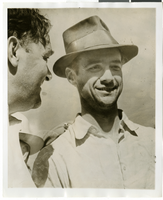
Photograph of Howard Hughes after arriving in Minneapolis, Minnesota, July 14, 1938
Date
1938-07-14
Archival Collection
Description
The black and white view of Howard Hughes in Minneapolis, Minnesota. Description printed on photograph's accompanying sheet of paper: "Howard Hughes at Minneapolis to refuel before leaving for Floyd Bennett Field to complete a round the world flight."
Image

Photograph of Howard Hughes sitting in the cockpit of the XF-11 preparing for his first test flight in Culver City, California July 7, 1947
Date
1947
Archival Collection
Description
Transcribed from press release attached to back of photo: "NEW PHOTO PLANE TEST-FLOWN CULVER CITY, California, July 7 -- Howard Hughes, who designed and built the new FX-11 reconnaissance plane in conjunction with Air Materiel Command engineers, sits in the pilot's bubble-glass canopy preparing for the first test flight. One of the world's fastest long-range photo planes, the XF-11 can attain a speed of more than 400 miles per hour, Army officials said. It is powered by two 3000-horsepower radial engines with eight-bladed contra-rotating propellers. Outstanding features include a full-span flap, unique eight-camera layout, and exceptionally fast take-off." Transcribed from photo sleeve: "Howard Hughes sits in the cockpit of the XF-11, a reconnaissance plane that Hughes built and designed in conjunction with Air Materiel Command engineers. Hughes is preparing for his first test flight in Culver City, California July 7, 1947.
Image
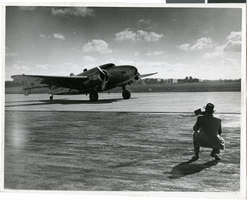
Photograph of Howard Hughes after arriving in Minneapolis, Minnesota, July 14, 1938
Date
1938-07-14
Archival Collection
Description
The black and white view of the Lockheed 14 aircraft in Minneapolis, Minnesota. Description written on back of photograph: "World-fame drops on City out of blue, sunny skies: Fame came to the municipal airport and the city of Minneapolis in a flash of silver and a roar at 7:38 am, July 14, 1938 when Howard Hughes swooped to Earth in his Droning Silver Bullet on his record breaking round-the-world flight. Photo-courtesy "The Minneapolis Star" Board of Park Commissions. 325 City Hall Minneapolis Minn."
Image
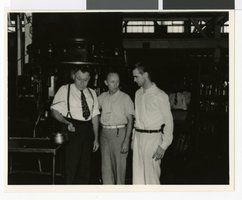
Photograph of Howard Hughes and two men, Houston, Texas, July 30, 1938
Date
1938-07-30
Archival Collection
Description
Howard Hughes (rt.)with two other unidentified men inside the Hughes Tool Co. factory in Houston.
Image
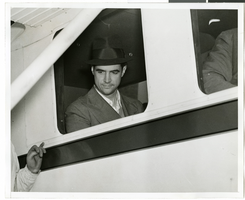
Photograph of Howard Hughes in the Lockheed 14, New York, July 10, 1938
Date
1938-07-10
Archival Collection
Description
Howard Hughes sitting inside the Lockheed 14 aircraft in New York. Typed on a piece of paper attached to the image: "Hughes' Paris hop delayed by motor trouble. New York City-- Howard Hughes, millionaire oil man and speed flyer, in the cabin of his huge Lockheed plane as he waited impatiently for a crew of mechanics to repair one of the motors so that he could take off for Paris. He was forced to give up his plans to leave on July 9th when mechanics found that it would be impossible to change the 18 cylinders of his motors in time. Crews worked all night at the job. Rough spots were found in the cylinders during fuel consumption tests. Credit Line (ACME) 7/10/38 Burs SF."
Image
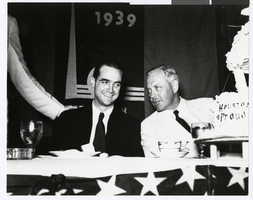
Photograph of Howard Hughes and Noah Dietrich, Houston, Texas, July 30, 1939
Date
1938-07-30
Archival Collection
Description
Howard Hughes (left) Noah Dietrich at a Hughes Tool Company celebration in Houston, Texas in 1939.
Image
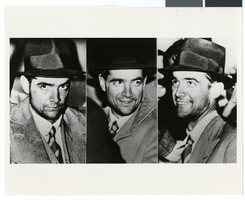
Photograph of three faces of Howard Hughes, New York, July 14, 1936
Date
1936-07-14
Archival Collection
Description
Three head shots of Howard Hughes in the back seat of a car enroute to his hotel in New York.
Image
Pagination
Refine my results
Content Type
Creator or Contributor
Subject
Archival Collection
Digital Project
Resource Type
Year
Material Type
Place
Language
Records Classification
